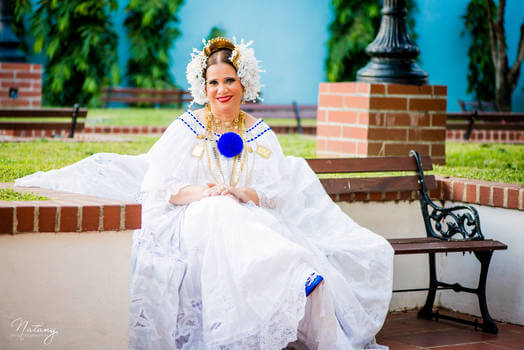Best Mexican Wedding Dress Styles: Vibrant Traditions and Timeless Elegance
Introduction
When you envision a traditional Mexican wedding, what image comes to mind? Chances are it involves a breathtakingly beautiful bride adorned in an intricately embroidered dress, rich with symbolism and cultural heritage. The Mexican wedding dress is more than just a garment – it’s a celebration of tradition, an embodiment of history, and a tapestry woven with stories passed down through generations. The intricate lacework and vibrant colors of the Mexican wedding dress symbolize the rich cultural heritage and joyful celebrations of Mexico.
For centuries, these dresses have been a canvas upon which the vibrant threads of indigenous and Spanish colonial influences have intertwined, creating a unique sartorial expression that is visually stunning and deeply rooted in cultural significance. From the delicate lace and embroidery that adorn the sleeves to the intricate patterns that dance across the skirt, each element holds a symbolic meaning that pays homage to the diverse traditions that have shaped Mexican culture.
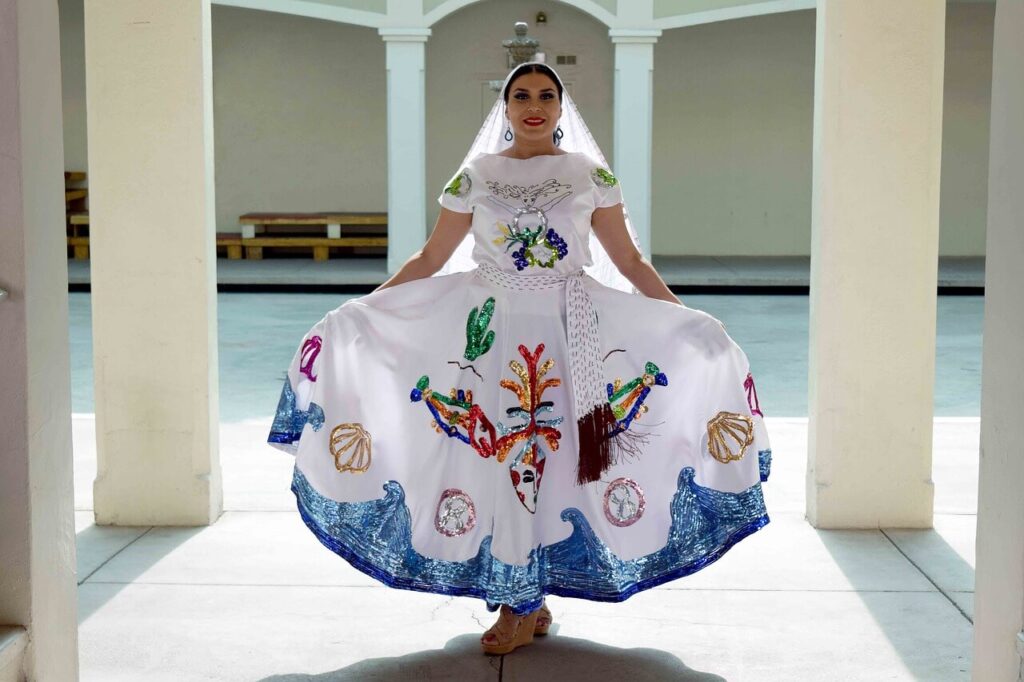
Beyond their aesthetic appeal, Mexican wedding dresses are a testament to the enduring resilience of a people who have fiercely preserved their cultural identity amidst the tides of change. They are a living legacy, a bridge that connects the past to the present, ensuring that the stories and traditions of ancient civilizations continue to be woven into the fabric of modern-day celebrations.
In this comprehensive exploration of Mexican wedding dresses, we will journey through their rich history, uncovering the origins and evolution of these captivating garments. We will delve into the symbolic elements that imbue each dress with profound meaning, revealing the complex web of religious and cultural factors that have influenced their creation. From the vibrant hues that celebrate life and love to the intricate embroidery that whispers tales of ancestral wisdom, we will unlock the secrets within every stitch and fold.
So, join us as we celebrate the enduring beauty and cultural significance of Mexican wedding dresses, and allow yourself to be transported to a world where tradition and modernity converge in a breathtaking display of artistry and heritage.
The Origins and History of Mexican Wedding Dresses: A Journey Through Time and Tradition
The Mexican wedding dress is a stunning tapestry woven from threads of diverse cultural influences, each strand telling a story of the rich heritage that has shaped this enduring tradition. To truly appreciate these garments’ beauty and significance, we must journey through time, tracing their origins and evolution across the centuries.
Pre-Hispanic Influences
Long before the arrival of Spanish conquistadors, the indigenous civilizations of Mexico had already mastered the art of textile creation. The Aztecs, Mayans, and other ancient cultures were renowned for their intricate weaving techniques and colorful natural dyes made from minerals, plants, and even insects like cochineal.
These pre-Hispanic traditions laid the foundation for the symbolic use of colors, patterns, and motifs that would later become integral to Mexican wedding dress designs. For instance, red, extracted from the precious cochineal insect, held profound significance, representing life, fertility, and passion – fitting symbolism for garments meant to celebrate the union of two souls.
Moreover, the geometric patterns and intricate embroidery found in traditional Mexican wedding dresses can be traced back to the textile artistry of these ancient civilizations. For example, the stepped fret and cross motifs were prevalent in Mesoamerican art and textiles, carrying symbolic meanings related to the cosmos, duality, and the four cardinal directions.
Spanish Colonial Era
In the 16th century, the arrival of Spanish conquistadors brought about a fusion of cultures that would forever reshape the sartorial traditions of Mexico. The introduction of European styles, fabrics, and techniques, such as lace and silk, intertwined with indigenous textile practices, giving birth to a unique blend that would become the hallmark of Mexican wedding dresses.
One of the most iconic examples of this cultural fusion is the Puebla dress, which emerged in Puebla during the colonial era. This dress featured the distinctive China Poblana style, characterized by a square-cut neckline, puffed sleeves, and a long, flowing skirt adorned with intricate embroidery and lace.
The rebozos, intricately woven shawls traditionally worn by indigenous women, also became a staple accessory for Mexican brides, often draped over the shoulders or used as a veil. These shawls were not only functional but also held deep symbolic meanings, representing protection, fertility, and the embrace of Mother Earth.
| Pre-Hispanic Influences | Spanish Colonial Influences |
| Natural dyes and pigments | Lace and silk fabrics |
| Geometric patterns | European styles and cuts |
| Symbolic motifs | Rebozos and mantillas |
| Intricate weaving techniques | Catholic religious symbolism |
Modern Mexican Wedding Dress Traditions
As Mexico gained independence and evolved into a modern nation, its wedding dress traditions continued to be shaped by regional influences and the artistry of contemporary designers. Each region of the country developed its distinct style, often influenced by the local indigenous communities and their textile heritage.
For instance, in the southern state of Chiapas, the Chiapaneca dress emerged as an iconic representation of the region’s rich cultural tapestry. This dress features a square-cut neckline, intricate floral embroidery, and a long, flowing skirt adorned with ribbons and tassels, reflecting the vibrant traditions of the Tzotzil and Tzeltal communities.
Contemporary Mexican fashion designers have played a crucial role in preserving and evolving the tradition of Mexican wedding dresses, introducing modern interpretations while honoring these garments’ symbolic elements and cultural significance. Designers like Carla Fernández and Alejandro Carlín have become renowned for their ability to blend traditional techniques with contemporary silhouettes, creating stunning pieces that are both timeless and avant-garde.
As we delve deeper into the origins and history of Mexican wedding dresses, We find a vibrant tapestry made from several cultural strands, each stitch carrying the stories and traditions of a people who have fiercely guarded their heritage amidst the tides of change. These dresses are not mere garments but living legacies, reminders of the resilience and creativity that have shaped the vibrant cultural fabric of Mexico.
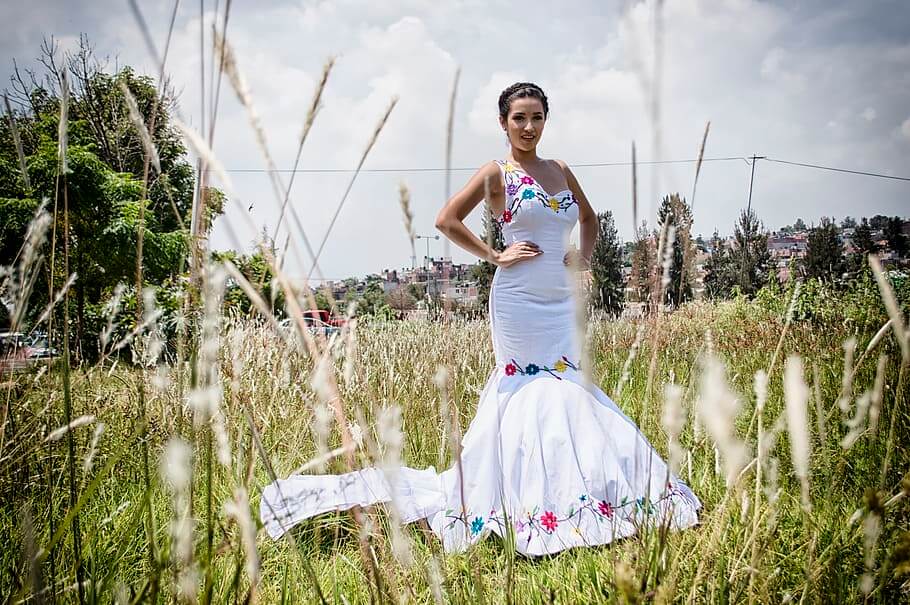
Unraveling the Symbolism: The Symbolic Elements and Meanings of Mexican Wedding Dresses
One must comprehend the rich tapestry of symbolism woven into each minute detail of Mexican wedding dresses in order to fully appreciate their depth and beauty. From the vibrant hues that dance across the fabric to the intricate patterns and embroidery that adorn the garments, each element carries a profound cultural and spiritual significance, telling a story passed down through generations.
Colors and Patterns
In Mexican wedding dresses, color is not merely an aesthetic choice – it is a powerful language that speaks of tradition, spirituality, and the celebration of life itself. The color white, a universal symbol of purity and innocence, is often the primary hue chosen for the dress, reflecting the bride’s virtue and the sanctity of the union.
However, the vibrant accents of color truly bring these garments to life, each hue carrying its symbolic weight. The bold red, derived from the precious cochineal insect, represents passion, fertility, and the Sun’s life-giving force. Green, a hue drawn from the verdant landscapes of Mexico, symbolizes Growth, renewal, and the cycle of life.
| Color | Symbolic Meaning |
| White | Purity, innocence |
| Red | Passion, fertility, life |
| Green | Growth, renewal, nature |
| Blue | Sky, water, spirituality |
| Yellow | Sun, warmth, joy |
Patterns and motifs, too, hold profound significance in Mexican wedding dress designs. The stepped fret, a geometric pattern with roots in pre-Hispanic cultures represents life’s duality and the interconnectedness of all things. The cross motif, deeply rooted in Catholic symbolism, serves as a reminder of faith and the spiritual journey that marriage represents.
Floral patterns, often rendered in intricate embroidery, are not mere decorative elements but a celebration of the natural world and its abundance. Each flower holds its symbolic meaning, with the marigold representing the Sun and the dahlia symbolizing dignity and elegance.
Accessories and Embellishment
No Mexican wedding dress is complete without its carefully chosen accessories and embellishments, Each one functioning as a potent symbol that gives the whole design more depth and significance.
The mantilla, a traditional lace veil or shawl, is often draped over the bride’s head, representing humility and respect for the sacred marriage union. The rebozo, a woven shawl with roots in indigenous traditions, is a functional accessory and a symbolic embrace of Mother Earth and her nurturing qualities.
Embellishments such as ribbons, tassels, and sequins are more than mere decorative flourishes; they are symbolic representations of the joy, celebration, and vibrancy that accompany the momentous occasion of a wedding.
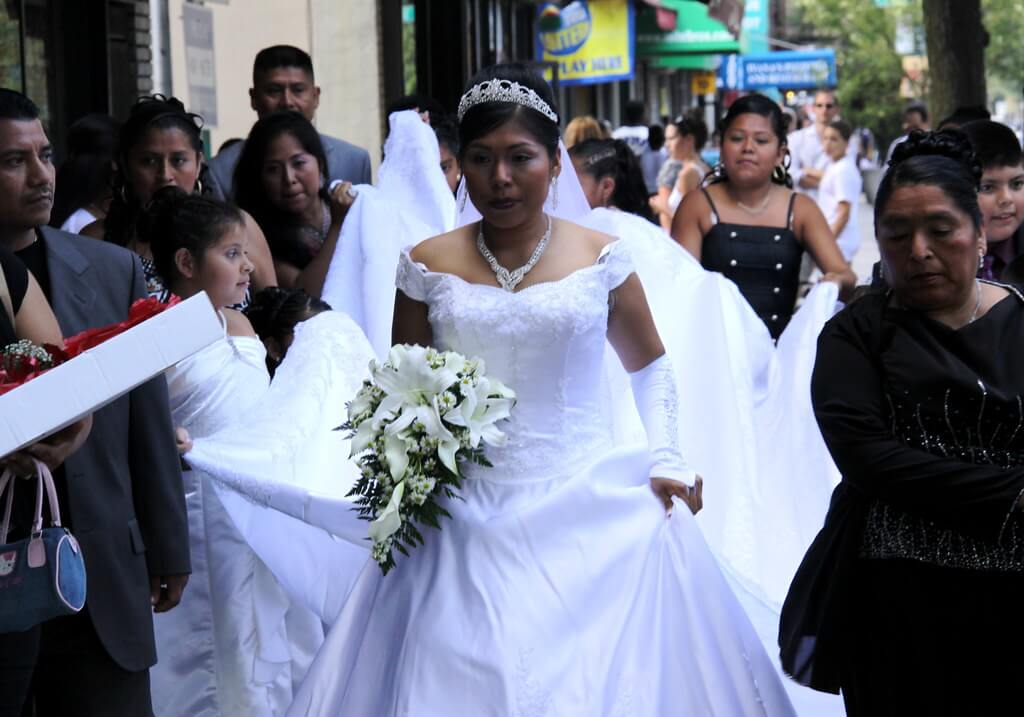
Symbolic Accessories and Embellishments:
- Mantilla (Lace Veil/Shawl): Humility, respect for marriage
- Rebozo (Woven Shawl): Embrace of Mother Earth, nurturing
- Ribbons: Joy, celebration
- Tassels: Vibrancy, liveliness
- Sequins: Radiance, festivity
Cultural and Religious Influences
At the heart of the symbolic elements found in Mexican wedding dresses lies a rich tapestry of cultural and religious influences woven together to create a unique and profoundly meaningful expression of heritage and belief.
The indigenous traditions of pre-Hispanic civilizations, with their reverence for nature and the cosmic cycles, have left an indelible mark on the symbolism found in these garments. The use of natural dyes, the incorporation of geometric patterns, and the representation of elements like the Sun and Mother Earth all pay homage to the ancient wisdom of Mexico’s first peoples.
However, the arrival of Spanish colonizers and the subsequent influence of Catholicism also shaped the symbolic language of Mexican wedding dresses. The cross motif, so prevalent in many designs, acts as evidence of the persistent faith and fervent religious devotion weaved throughout Mexican society.
Even adorning oneself in these intricate garments carries symbolic weight, representing the bride’s transition into a new phase of life and her acceptance of the responsibilities and joys of marriage.
As you delve deeper into Mexican wedding dresses’ symbolic elements and meanings, you will find yourself on a journey that transcends mere fashion. These garments are living repositories of cultural legacy, each stitch and embellishment whispering tales of tradition, spirituality, and the enduring human desire to imbue life’s most profound moments with deep significance and beauty.
Mexican Wedding Dress Etiquette and Customs: Honoring Traditions with Grace and Reverence
Every aspect of Mexican wedding dress traditions is imbued with cultural significance and deeply rooted customs that must be respected and honored. From selecting the perfect dress to the rituals and ceremonies surrounding its wear, these garments are not mere fashion statements but rather a celebration of heritage and a reverence for the sacred bonds of matrimony.
Selecting the Perfect Dress
Choosing a Mexican wedding dress is a decision that requires careful consideration, as it involves navigating a complex tapestry of cultural norms and expectations. The process often begins with consulting elders and seeking their guidance, as they serve as the guardians of tradition and can offer invaluable wisdom.
When selecting the dress, several factors come into play:
1. Regional Styles: Mexican wedding dresses are deeply rooted in regional traditions, with each state or region having distinct styles, colors, and embroidery patterns. A bride must carefully consider her family’s origins and heritage when choosing.
2. Symbolic Meanings: As we’ve explored, every element of a Mexican wedding dress holds profound symbolic significance. The bride must understand these meanings and choose a dress that aligns with her beliefs and values.
3. Family Heirlooms: In many Mexican families, wedding dresses are passed down through generations as cherished heirlooms. If a bride can wear a dress that has been part of her family’s history, it is considered a great honor and a powerful connection to her ancestral roots.
4. Cultural Appropriateness: While Mexican wedding dress traditions are meant to be celebrated, it is crucial to avoid cultural appropriation. Brides from non-Mexican backgrounds should approach these garments with respect and seek guidance from cultural experts to ensure their choices are appropriate and respectful.
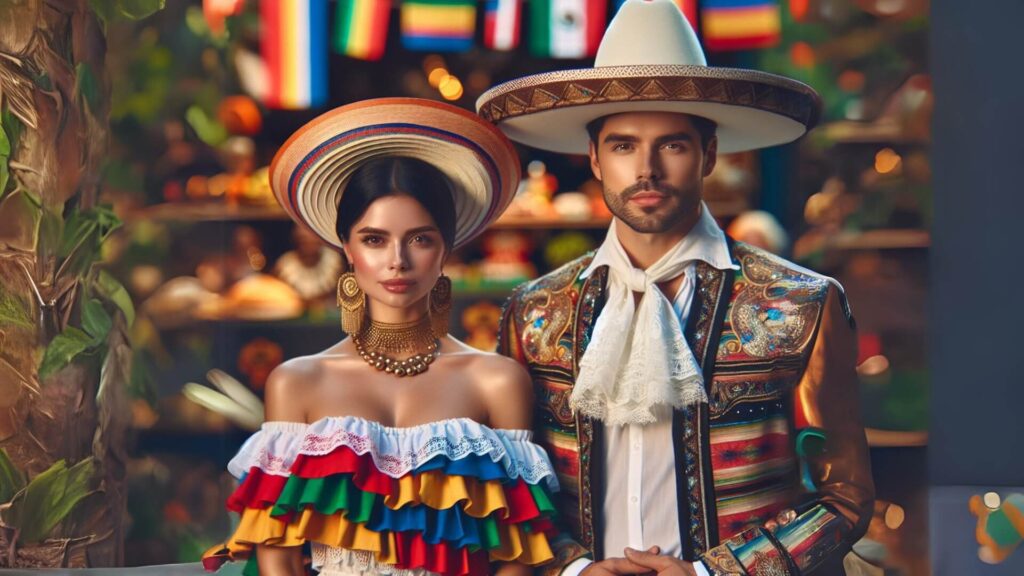
Wedding Day Rituals and Traditions
Once the perfect dress has been chosen, the bride must prepare herself for the various rituals and traditions that accompany her wear on the wedding day. These customs honor the cultural heritage and imbue the occasion with profound spiritual and emotional significance.
One of the most cherished traditions is the blessing of the dress. Before the ceremony, a priest or respected elder will perform a ritual blessing, asking for divine protection and blessings upon the union. During this ritual, the bride may be adorned with symbolic accessories, such as the rebozo or mantilla, further emphasizing the spiritual nature of the occasion.
The bride’s dress will be the centerpiece of several other customs and rituals throughout the ceremony and reception. For instance, the arras (unity coins) may be incorporated into the dress’s embroidery or attached to the train, symbolizing the couple’s commitment to sharing worldly goods.
Wedding Day Rituals and Traditions:
- Blessing of the dress by a priest or elder
- Adorning the bride with symbolic accessories (rebozo, mantilla)
- Incorporating the arras (unity coins) into the dress’s design
- Special dances or processions highlighting the dress’s beauty
It is important to note that these traditions may vary among different regions and families, and the bride and her loved ones need to seek guidance from cultural experts or elders to ensure they are honoring the customs most respectfully and authentically possible.
Preserving the Legacy: Care and Preservation of Mexican Wedding Dresses

A Mexican wedding dress is not merely a garment; it is a priceless heirloom that carries the weight of generations of cultural heritage and family history. As such, proper care and preservation are paramount to ensuring that these exquisite creations can be passed down to future generations, allowing the traditions and stories they embody to endure.
Proper Care and Storage
Maintaining the integrity and beauty of a Mexican wedding dress requires a delicate touch anda thorough comprehension of the components and methods utilized in its creation. Here are some essential tips for caring for and storing these treasured garments:
1. Cleaning: Professional dry cleaning or gentle hand-washing with specialized detergents is recommended for most Mexican wedding dresses. Harsh chemicals or machine washing can damage delicate fabrics, embroidery, and lace.
2. Storage: Proper storage prevents damage from light, moisture, and pests. Acid-free boxes or breathable garment bags are ideal for long-term storage, and dresses should be stored in a cool, dry, and dark environment.
3. Handling: Avoid snagging or crushing intricate embroidery or delicate fabrics when handling a Mexican wedding dress. Gloves should be worn to prevent oils from the skin from damaging the materials.
4. Repair and Restoration: Even with the best care, dresses may require repair or restoration over time. Seeking the expertise of skilled artisans specializing in traditional Mexican textiles and techniques is crucial to maintaining the dress’s authenticity and preserving its cultural significance.
Passing Down Traditions
Perhaps the most meaningful aspect of preserving Mexican wedding dresses is the opportunity to pass them down as family heirlooms, ensuring that the stories and traditions they represent are woven into the fabric of future generations.
For many Mexican families, passing down a wedding dress is a sacred ritual steeped in emotion and reverence for one’s ancestral roots. It is a tangible connection to the past, a reminder of the resilience and cultural pride that have sustained these traditions through centuries of change and adversity.
As a bride receives a family heirloom dress, she becomes the custodian of a living legacy, tasked with preserving not only the physical garment but also the rich tapestry of stories, customs, and symbolic meanings it represents. It is a humbling and empowering responsibility as she becomes part of an unbroken chain stretching back through generations of strong, resilient women who have upheld the traditions of their ancestors.
Conclusion: Celebrating the Enduring Legacy of Mexican Wedding Dresses
As we conclude our exploration of Mexican wedding dresses, we are left with a profound appreciation for the enduring legacy and cultural significance that these garments represent. More than mere articles of clothing, they are living repositories of history, tradition, and the indomitable spirit of a people who have fiercely guarded their heritage amidst the tides of change.
From the vibrant colors and intricate patterns that adorn their surfaces to the symbolic meanings woven into every stitch, Mexican wedding dresses are a visual tapestry that tells the story of a rich and diverse cultural tapestry. They are a celebration of the indigenous roots that predate the arrival of European settlers and a testament to the resilience and adaptability of a people who embraced the influences of other cultures while never losing sight of their traditions.
These garments are not mere relics of the past but living, breathing expressions of a culture that continues to evolve and thrive.
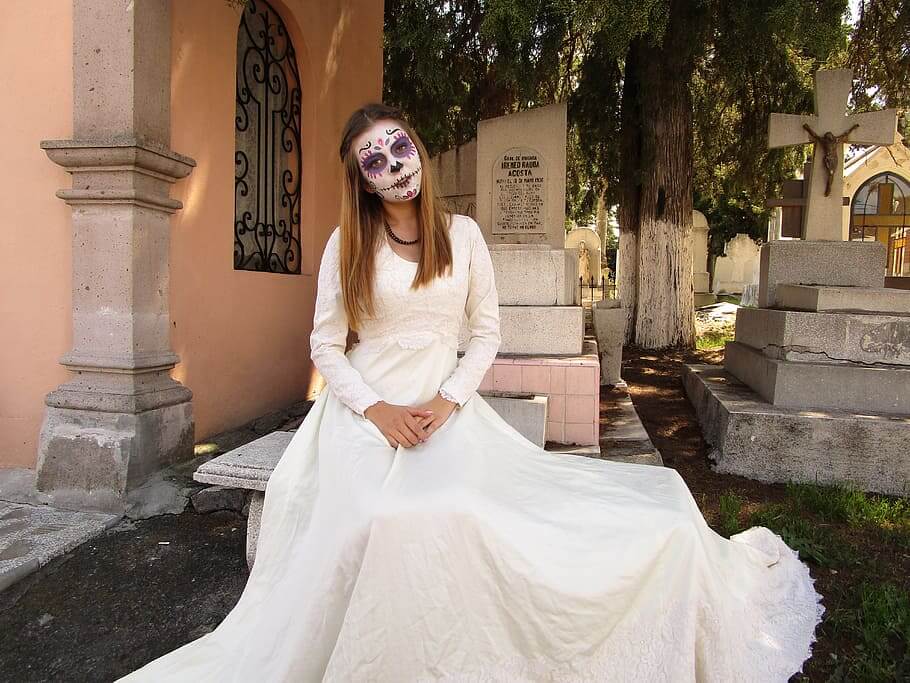
Whether you are a bride seeking to honor your heritage by wearing a traditional Mexican wedding dress or admire the stunning artistry and cultural significance they represent, we hope this exploration has opened your eyes to the depth and beauty of these incredible garments.
So, let us celebrate the enduring legacy of Mexican wedding dresses, for they are a testament to the past and a powerful reminder of the resilience and creativity that will shape the cultural tapestry of generations yet to come.

